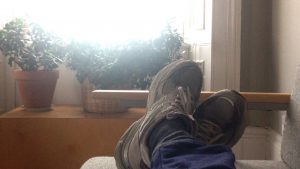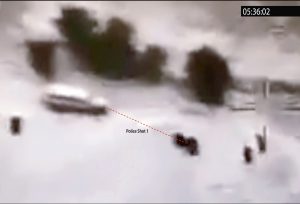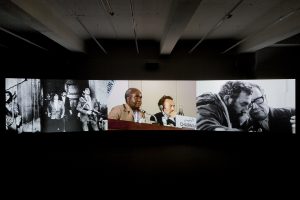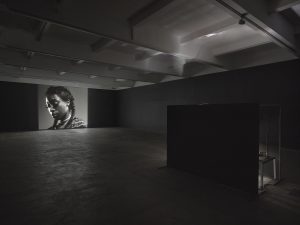The Turner Prize 2018: A Common Ground for Empathy, by Fernando Chaves Espinach
Perhaps it’s too much to ask from a work of art some sense of direction in the world, some kind of fail proof compass that will get you from door to door. But then again, a piece of art may hand one out to you even when you’re not asking for it.
On a recent morning, visiting the Turner Prize exhibition at Tate Britain, Charlotte Prodger’s warm, textured 32-minute video BRIDGIT (2016), this year’s winner, seemed to speak from a place of uncertainty, yet with such emotional sincerity that it felt liberating. BRIDGIT, shot on her iPhone, sticks close to her body, which is also to say it overflows with her thinking and her passions.

BRIDGIT (2016), single channel video with sound, 32 minutes [still]. Courtesy of the artist, Koppe Astner, Glasgow, and Hollybush Gardens, London.
From her native Scotland’s landscapes to the ever-changing sea, and delving deep into history in search of Neolithic deity Bridgit, Prodger weaves a personal history from the dullness of a hospital ward where she lies recovering. The anaesthetized body worms its way back into the world; the voice-over speaks of her time working at a residential care home and her coming out in Aberdeenshire.
‘One of the great difficulties facing anyone who attempts to unravel the problems of the ancient world is that of names,’ we hear: referring to Bridgit’s many ancient names. But as Prodger’s self-portrait shift from fragment of her life to another, from the muddled past to the resilient, queer body of the present, naming is still a task fated to remain incomplete.
As part of the Turner Prize show, Prodger’s work is the most intimate among several pleas for a common ground for empathy and listening. The work of the other finalists is more overtly political; but together, the exhibition as a whole could not be more of the moment. It might be the most political Turner Prize exhibition in years, as some critics suggest, and much will be made of it being entirely made up of moving image works.
Luke Willis Thompson’s 35mm portraits of black suffering, Naeem Mohaiemen’s feature-length explorations of history and failed futures, and Forensic Architecture’s painstaking reconstruction of a crime scene in the Negev Desert paint a portrait of a world obstinately decided not to listen to those in pain and mourning. But as particular moments of each piece suggest, there are cracks in the armour, possibilities for in which the light to enter.
This may not be immediately apparent while watching Forensic Architecture’s ‘counter-investigations’, which seek out to weaken the State’s monopoly of the truth. In our era thirsty for regaining trust in facts their projects are about the attack on Bedouin settlements by Israeli authorities. Two ongoing investigations make up the installation, entitled The Long Duration of a Split Second: Killing in Umm al-Hiran 18 January 2017 (2017) and Traces of Bedouin Inhabitation 1945-present (2015-ongoing). One untangles lies and truth in the aftermath of an Israeli police raid during which an officer and a Bedouin villager were killed; the other seeks to prove the continuity of Bedouin settlement in Negev/Naqab since before the establishment of Israel, which now denies them ownership of the land.

Forensic Architecture. Killing in Umm al-Hiran, 18 January 2017 [still] Annotations by Forensic Architecture on Israeli police footage.
By laying out their interdisciplinary methodologies of ‘counter-forensics’, FA defends the power of the image as testimony, regardless of claims to the contrary from those who believe that digitisation has rendered it forever untrustworthy. The entry point is the video fragments from the killing of Yaqub Musa al-Qi’an, projected on a curved screen that also shows the technical specifications of the recording device.
Together with activists of ActiveStills, FA strive to demonstrate that al-Qi’an’s murder was the consequence of police provocation, and not because the authorities reacted to his ‘terrorist’ attack. As this work flows into the gallery space, the question of audience does come up. Is anybody listening? Must the archaeologists of injustice reach out to the art world to carve a tiny space for their protests? But judging by the visitor’s attentive listening and reading of their timelines, maps, videos and photographs, there are still spectators willing to know.
Discouraging at first, FA’s timeline of the killing and the subsequent Twitter and media struggles over what really happened pays off at the very end. For in spite of the failure to pursue the court case successfully, there might be a retrial. One must hold onto whatever lifeline is left when all possibilities seem exhausted. The villagers eventually gave up and relinquished their rights to the land, but the fact that their claims can find in the technology a bridge to the world inspires some trust in the future of such collective enterprises.
This hope, of course, stands in the shadow of past failures − failed futures, more precisely, as shown in Naeem Mohaiemen’s 89-minute, three-channel video Two Meetings and a Funeral (2017). Using archival work and critical guidance of Indian Marxist historian, Vijay Prashad, the film takes a look at the failure of the non-aligned movement of nations and Third World socialism to form a cohesive, lasting alternative to globalised capitalist colonialism.

Naeem Mohaiemen. Two Meetings and Funeral, 2017, three-channel. Installation, Hessiches, Landesmuseum, Kassel, documenta 14. Commissioned by documenta 14, co-commissioned by Sharjah Art Foundation and Ford Foundation/Just Films. Supported by Arts Council, Bengal Foundation, Tensta Konsthall. Additional support by Experimenter and Tate Films. Photo: Michael Hast.
Most unnerving perhaps are the passages in which Prashad goes through emptied archive drawers at the United Nations, where the histories of struggle of many nations were once preserved. Once digitised, however, they feel as empty as these cases, lost forever in the noise that drowned out possibilities for a different future. Dreams and fantasy can do little in the face of loneliness, as faced by the man trapped in the airport of Tripoli Cancelled (2017). As he recounts his decade there, during which, like in Luis Buñuel’s The Exterminating Angel (1962), he just can’t exit, we go through the many emotions that sustain his humanity. We endure, despite everything.
Endurance is evoked in the most discussed work exhibited at the Turner show before Charlotte Prodger’s win. Uneasiness, however, is the best word to describe the feeling of watching Luke Willis Thompson’s 35mm moving portraits of black experience. Of European and Fijian descent, the artist faced protests for appropriating ‘black pain’ by using, in autoportrait (2017), the image (and collaboration) of Diamond Reynolds, whose partner Philando Castile’s assassination by the police she memorably and painfully shared with the world via Facebook.

Luke Willis Thompson, autoportrait, 2017. Installation view, Chisenhale Gallery. Commissioned by Chisenhale Gallery and produced in partnership with Create. Courtesy of the artist. Photo by Andy Keate.
Whose right is it to represent is not only the lingering question confronted in the work, but also how and why her image is presented as it is, explicitly deprived of her voice as only the whirr of the projector accompanies the spectator’s experience of the film. It’s a question also present when watching Cemetery of Uniforms and Liveries (2016), which shows two four-minute portraits of the grandson and son of two women killed by the police in London (Dorothy Groce, in 1985, and Joy Gardner, in 1993) and reference Andy Warhol’s Screen Tests. Why should they be immobile and silent? What would they tell us if they could?
But humanity does bridge the distance imposed by the presentation of the films, in a layout that foregrounds the tower in which the strips of film snake their way into the projector. Their fragility reminds us of their materiality. It does so in _Human (2018), a delicate look into one of Donald Rodney’s skin sculptures from the mid-90s, culled from his own, suffering body. And it shows in autoportrait, in which, against the degraded images that gave us Diamond Reynold’s scream for life, Luke Willis Thompson offers us a film, as a metaphor maybe, but perhaps as a way of celebrating resilience. Complicated as the works are, as emotions well-up in their subjects’ eyes, one is moved to approach them no longer ‘through a glass, darkly, but face to face’, in the words of St. Paul.
Maybe such a reference to spiritual truth evokes long-dead aspirations. But coming back to BRIDGIT, that aspiration seems not so distant. In her radical spirituality, though, it is a matrilineal legacy of women’s self-determination and imagined futures. Sandy Stone is quoted: ‘The idea behind taking a name appropriate to one’s current circumstance was that identity isn’t static,’ remembering Bridgit’s contemporaries. But also referenced is the lesbian separatist collective, Olivia Records, who dared envisage an alternative future, a parallel world owned by no one but themselves.
That simply put is what despite failure many millions have strived for in the past and is what we call ‘History’. Is that hope enough to carry oneself into the future?
Thanks to Helen de Witt and the Artists’ Film and Video for the conversation about the exhibition
[All images Courtesy of Tate Britain]
The Turner Prize exhibition, featuring works by Charlotte Prodger, Naeem Mohaiemen, Luke Willis Thompson, and Forensic Architecture, is open until January 6 at Tate Britain.

